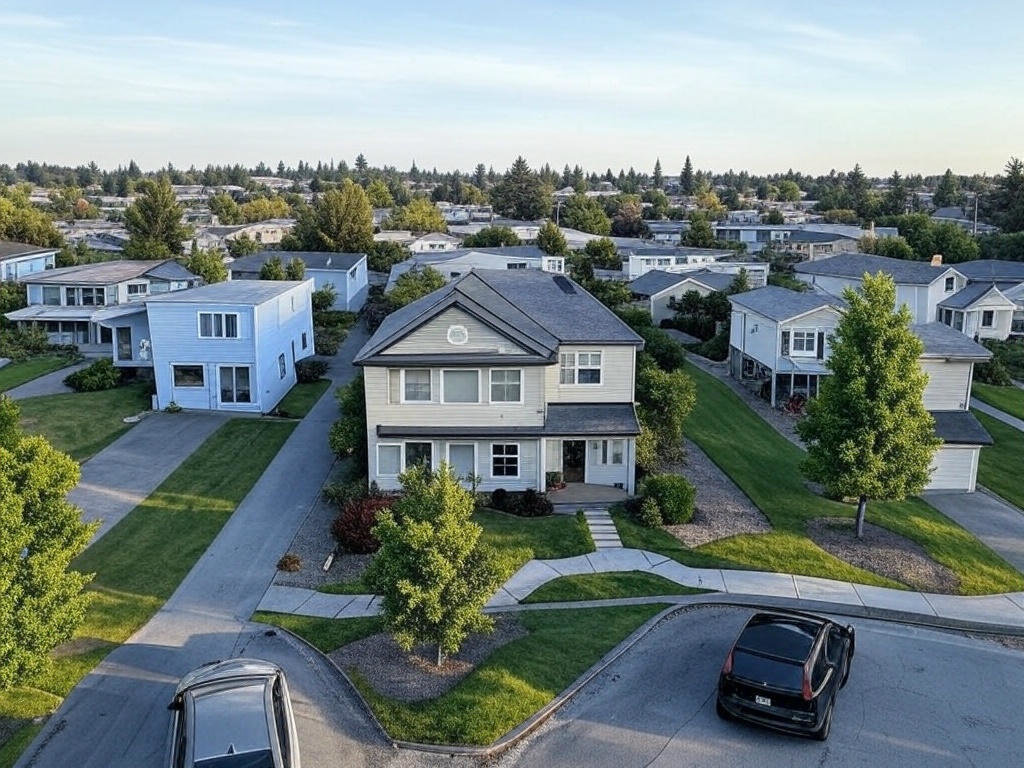Table of Contents
In a real estate world dominated by leverage strategies, growing a substantial portfolio without debt might seem counterintuitive. Yet a growing number of investors are discovering the security and long-term advantages of this approach, especially valuable in 2025’s unpredictable economic landscape.
Research shows that building a real estate empire without mortgages is entirely achievable through disciplined saving, strategic partnerships, and creative acquisition methods. While potentially slower than leveraged approaches, debt-free investing shields investors from interest rate fluctuations, foreclosure risks, and market volatility.
This comprehensive guide explores proven strategies to scale your real estate investments using only cash, leveraging insights from industry experts and current market trends as of May 2025.
Understanding Debt-Free Real Estate Investing
Debt-free real estate investing means acquiring and managing properties without mortgages or loans. This approach prioritizes financial independence and minimizes risk during economic downturns or personal financial challenges.
With mortgage rates hovering between 6-7% in 2025, cash purchases can be particularly advantageous. Though requiring more upfront capital, the absence of debt obligations provides unmatched flexibility and peace of mind.

Why Consider the Debt-Free Approach?
- Financial security: No risk of foreclosure during market downturns
- Higher cash flow: No monthly mortgage payments reducing profits
- Greater flexibility: Freedom to sell, hold, or improve properties on your timeline
- Reduced stress: Immunity to interest rate fluctuations and lender requirements
- Negotiation advantage: Cash offers typically secure 5-10% discounts from motivated sellers
As Mark Ferguson, founder of InvestFourMore, notes: “When you buy properties with cash, you control the asset completely. This control allows you to make decisions based on opportunity rather than obligation.”
5 Proven Strategies for Growing Your Portfolio Without Leverage
1. Cash Accumulation and Reinvestment Strategy
The foundation of debt-free investing is systematic saving and reinvestment. This approach requires discipline but creates a powerful compounding effect over time.
How it works:
- Save aggressively to acquire your first property outright
- Channel 80-100% of rental income toward your next purchase
- Repeat the process, building a portfolio property by property
Real-world example: Following Coach Carson’s “All-Cash Plan,” an investor starting with $60,000 in savings and contributing $5,000 annually can purchase duplexes generating $7,200 yearly in net rent each. Within 13.5 years, this approach can result in owning six duplexes (12 units), producing $43,200 annually in passive income.
2. Strategic Partnerships and Joint Ventures
Teaming up with other cash investors multiplies purchasing power without introducing debt.
Key partnership models:
- Equity partnerships: Investors pool cash equally and share ownership
- Cash + expertise partnerships: One partner provides funding, another provides management skills
- Syndication: Lead investor organizes multiple cash investors for larger acquisitions
“The right partnership can accelerate your timeline by 5-7 years compared to investing solo,” explains real estate educator Kathy Fettke. “The key is finding partners with complementary skills and aligned investment philosophies.”
3. Property Recycling Strategy
This approach involves strategically selling appreciated properties to fund multiple new acquisitions.
Implementation steps:
- Purchase properties with strong appreciation potential
- Hold until significant equity is built (typically 3-5 years)
- Sell and use proceeds to acquire multiple cash-flowing properties
- Utilize 1031 exchanges to defer capital gains taxes when appropriate
For example, selling a single-family home in a high-cost area might provide capital for 3-4 rental units in growing markets with stronger cash flow potential.
4. Value-Add Property Improvements
Enhancing property value through strategic improvements accelerates equity growth without debt.
Most effective improvements for ROI:
- Kitchen and bathroom modernizations
- Energy efficiency upgrades
- Adding bedrooms within existing footprints
- Basement or attic conversions
- Curb appeal enhancements
Research by Remodeling Magazine indicates that strategic kitchen updates can return 72-80% of costs immediately through increased property value, while energy efficiency upgrades typically provide 2-3x returns through utility savings and increased rents.
5. Distressed Property Acquisition
Cash investors have significant advantages when purchasing undervalued or distressed properties.
Types of opportunities:
- Foreclosures and short sales
- Estate sales and probate properties
- Properties with deferred maintenance
- Motivated sellers facing financial challenges
- Tax lien properties
“Cash buyers in 2025 have a 68% higher chance of closing on distressed properties compared to financed buyers,” notes distressed property specialist David Phelps. “Sellers facing time constraints typically accept 12-15% discounts for guaranteed, fast closings.”
Benefits of Cash Real Estate Investing in Today’s Market
Financial Advantages
- Superior closing speed: Cash transactions close in 7-14 days vs. 30-60 days for financed deals
- Negotiation leverage: Cash offers typically secure 5-10% price reductions
- Elimination of financing costs: Saving 2-3% in loan origination fees and thousands in interest
- Higher cash-on-cash returns: A $200,000 property generating $2,000 monthly rent yields 12% annual returns without mortgage payments
Market Resilience Benefits
- Immunity to interest rate fluctuations: No impact from the Federal Reserve’s policy changes
- Protection during credit crunches: No dependence on lender approval during tight credit markets
- Ability to hold through downturns: Without debt service requirements, investors can weather market cycles
Operational Advantages
- Simplified accounting: No loan servicing or amortization tracking
- Reduced insurance requirements: No lender-mandated insurance minimums
- Greater flexibility in property use: Freedom to renovate, repurpose, or leave properties vacant
Overcoming Challenges of the Debt-Free Approach
Higher Initial Capital Requirements
The most significant barrier to debt-free investing is accumulating sufficient purchase capital.
Solutions:
- Start with lower-priced markets or property types
- Explore house hacking (living in one unit while renting others)
- Use retirement accounts like self-directed IRAs for tax-advantaged investing
- Consider fractional ownership through investment platforms
Slower Portfolio Growth
Without leverage, expansion typically occurs at a more measured pace.
Acceleration strategies:
- Focus on high cash-flow properties to speed up capital accumulation
- Target properties with value-add potential for faster equity building
- Utilize partnerships to increase acquisition capacity
- Implement the “BRRRR” method without the refinance component
Opportunity Cost Considerations
Capital tied up in real estate isn’t available for other investments.
Optimization approaches:
- Focus on cash flow efficiency (high returns relative to property value)
- Maintain a separate liquid emergency fund
- Diversify across multiple smaller properties rather than fewer large ones
- Balance real estate holdings with other investment vehicles
2025 Market Outlook for Cash Investors
The 2025 real estate landscape presents unique opportunities for debt-free investors:
Current Market Conditions
- Home prices: 4.1% annual appreciation as of Q1 2025
- Mortgage rates: Hovering between 6-7%, reducing competition from financed buyers
- Inventory levels: Gradually increasing, providing more options for discerning cash buyers
- Rental demand: Strong and growing, with national average rent increases of 3.8% year-over-year
Regional Opportunities
Top markets for cash investors in 2025:
- Midwest secondary cities: Affordable entry points with 8-10% cash returns
- Sunbelt growth markets: Strong population influx supporting appreciation
- Tertiary markets near major metros: Benefiting from remote work migration
- College towns with stable enrollment: Consistent rental demand regardless of economic conditions
- Areas with aging housing stock: Opportunities for value-add strategies
Emerging Trends Favoring Cash Buyers
- Builder liquidations: New construction oversupply in certain markets
- Baby boomer property transitions: Increasing inventory as owners downsize
- Rising insurance costs: Properties with insurance challenges favor cash buyers
- Tightening lending standards: Reducing competition at certain price points
Expert Case Study: The All-Cash Portfolio Plan
Financial educator Coach Carson’s debt-free investment roadmap illustrates the compounding power of all-cash investing:
The Strategy
Starting with $60,000 and investing $5,000 annually from employment income:
Year 1: Purchase first duplex for $60,000 generating $7,200 annual net rent Year 3: Buy second duplex combining savings and rental income Year 6: Acquire third duplex Year 8.5: Purchase fourth duplex Year 10.5: Buy fifth duplex Year 13.5: Obtain sixth duplex
The Result
After 13.5 years: Six duplexes (12 units) producing $43,200 annually in passive income, with zero debt and minimal risk.
“The approach mirrors Vince Lombardi’s football philosophy,” Carson explains. “Success comes not from complex strategies but from executing simple fundamentals consistently over time.”
FAQ: Debt-Free Real Estate Investing
Is debt-free investing viable in high-cost markets?
Yes, though it often requires starting with alternative approaches. Consider:
- Partnership investing to pool resources
- Beginning in adjacent affordable markets
- Starting with smaller properties like condos or townhomes
- Focusing on properties with value-add potential
How does the return on investment compare to leveraged approaches?
While leveraged investing typically produces higher ROI during appreciation cycles, debt-free investing often outperforms during flat or declining markets. A comprehensive analysis by BiggerPockets found that over 30-year periods including multiple market cycles, the difference in terminal wealth between all-cash and 75% leveraged portfolios was only 18% – significantly less than many investors assume.
What’s the minimum capital needed to start?
Debt-free investing can begin with as little as $30,000-50,000 in markets with affordable properties. However, the sweet spot for sustainable portfolio growth typically starts at $100,000-150,000, allowing for the purchase of properties with stronger cash flow characteristics.
How can I accelerate the timeline?
The most effective acceleration strategies include:
- House hacking your primary residence while saving aggressively
- Focusing exclusively on high cash-flow (10%+ annual returns) properties
- Implementing value-add improvements to boost equity and rental income
- Forming strategic partnerships to increase acquisition capacity
What types of properties work best for this approach?
Properties with these characteristics typically perform best for cash purchases:
- Lower price points relative to local markets
- Minimum 1% monthly rent-to-value ratio (preferably 1.5%+)
- Modest properties appealing to stable, long-term tenants
- Properties requiring cosmetic updates but sound structural elements
- Single-family homes and small multifamily (2-4 units)
Conclusion: Building Lasting Wealth Without Debt
Growing a real estate portfolio without leverage is not just possible—it’s a powerful strategy for building lasting wealth with minimal risk. By implementing the strategies outlined in this guide—strategic saving, targeted partnerships, property recycling, value-add improvements, and distressed property acquisition—investors can create substantial passive income streams without the burden of debt.
In 2025’s competitive market, cash buyers enjoy significant advantages, from negotiation leverage to immunity from financing challenges. While the debt-free approach requires patience and discipline, the financial freedom and peace of mind it provides make it an increasingly attractive option for long-term wealth building.
Remember that successful real estate investing is ultimately about the fundamentals: acquiring cash-flowing assets at good values and managing them effectively. With or without leverage, these principles remain the foundation of lasting success.
Have you implemented debt-free real estate strategies? Share your experiences in the comments below!
